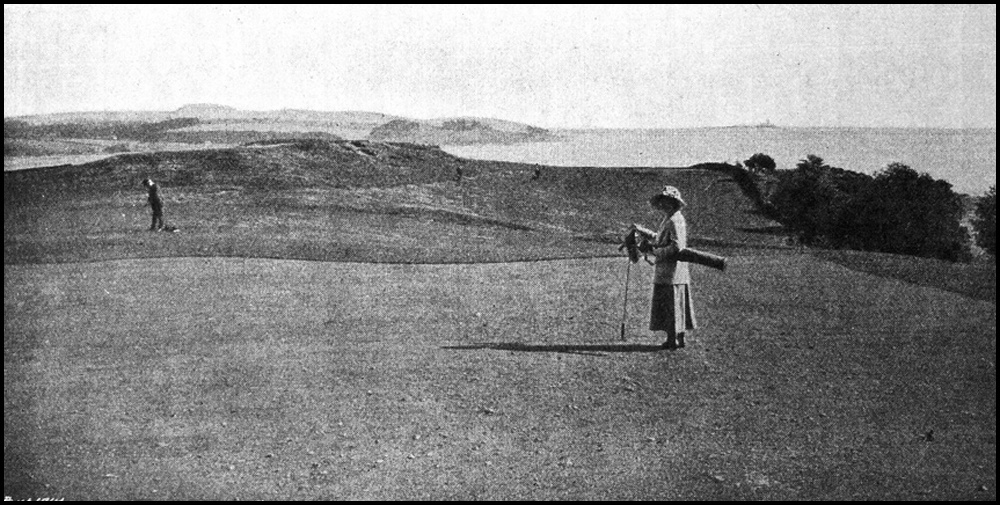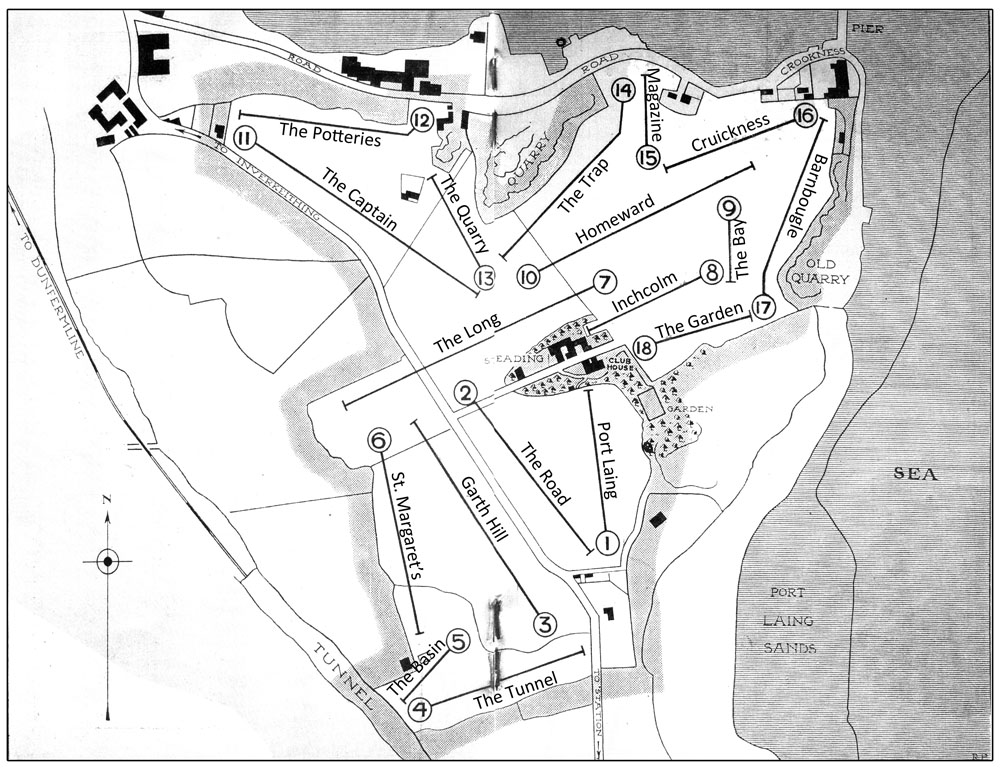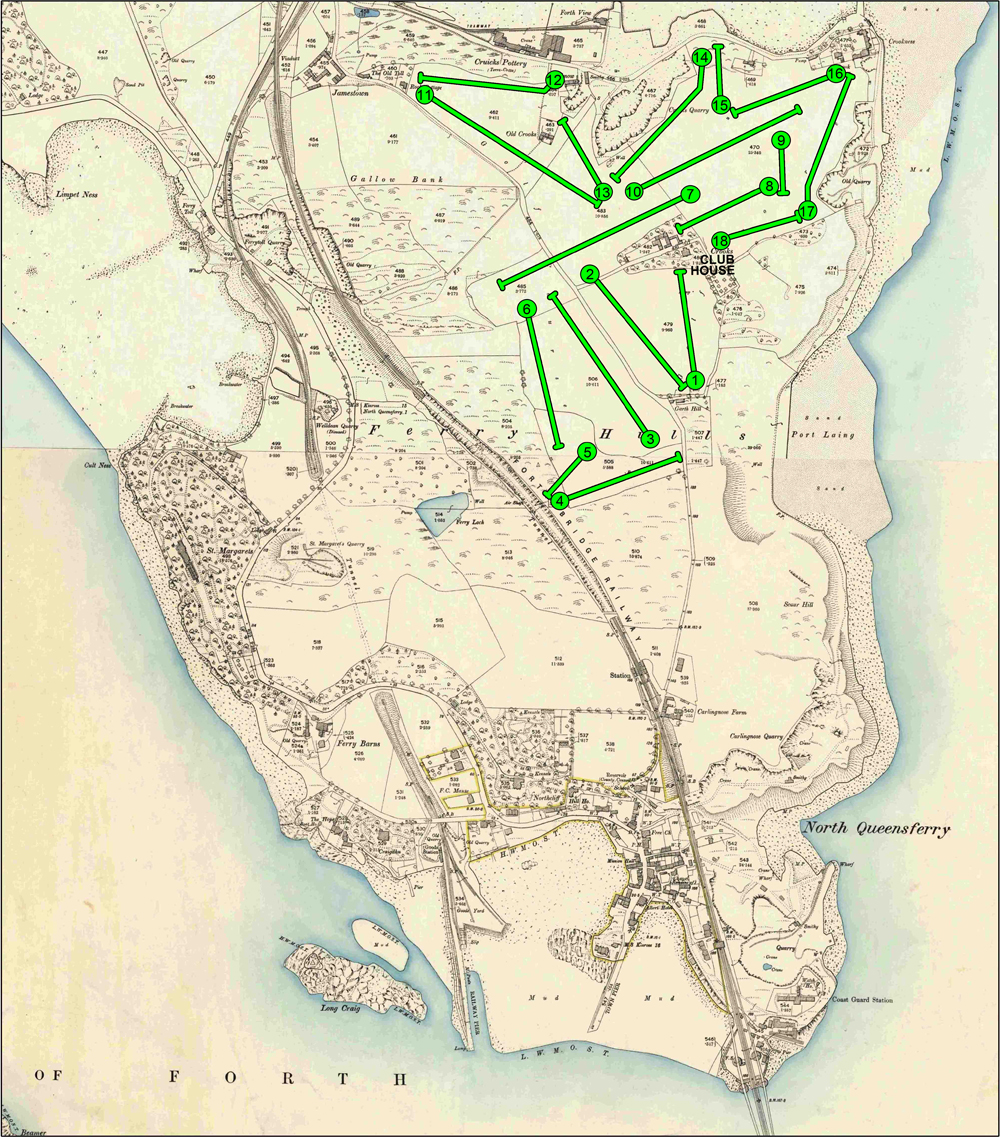The opening hole is comparatively “plain sailing”; but the road which forms the western edge to the club-house and a double hedge are immediately in front of the second green. The hazards proved an excellent test of the pitching capabilities of the players. A topped drive is punished by a hedge on the way to “Garth Hill”; but if the hedge is negotiated without trouble there is little prevent a golfer, who can handle his driver and brassey with ordinary skill, snatching a hole now and again from “bogey.”

The Third Green
Players must not run away with the idea that the fourth green is protected by a tunnel because the hole takes the name of “The Tunnel.” An explanation is to be found in the fact that while on the green a very sensitive golfer may hear the “roar” of a train in the railway tunnel which leads to the Forth Bridge. If a player takes care not to pull his drive he will pocket a hum-drum four. “The Basin” is a deep hole which has been scooped out on the highest point of the hills by the denudation of far-off days. From a neat pitch the ball may drop right into the basin and a two may be registered, but a miss is punished by whins and the remnants of a dry stone dyke, while a bad “slice” may send the “globe” down the northern slopes of the hill, and the last position of the player may be worse than the first.
Going to the sixth green the player drives from the high ridge to a flat stretch which lies at least 50 feet lower than the “Basin.” Just beyond a hedge the green lies on the top of one of the eminences of the hills, which during the South African War, some players persisted in designating “Spion Kop.” For the beginner “Spion Kop” is a severe test, and he has often to exercise a good deal of patience before he reaches the goal on the top of the “Delectable Mountains.” The ordinary player will find that a drive, a short iron, to be to be twenty yards back from the hedge, and nice “loft” will pay best. Two hedges and a road lie in front of the driver to the “Long Hole.” Hazards vanish after the drive, however, and the player who gets “well away” should reach the green in three comfortably. To equal “Bogey” he needs to putt.
From the eighth green a charming view of Inchcolm and other “emeralds of the Forth” is had, and so the hole takes the name of “Inchcolm.” A simple bunker protects the green and provides the only difficulty.
The ninth is a “tricky little hole,” which lies at a much lower altitude than the tees. Being surrounded by bunkers, a “trickle” down hill is often punished, and a wrist shot from a lofter will be found to be the safest play.
“Homeward” marks the beginning of the return on the homeward journey. Players do well to keep in mind that there is a dyke just beyond the hillock in front of the green. With care a very ordinary player should be able to procure a useful 5, or a 6 at most.
One of the earliest players on the Ferry Hills named the eleventh green “The Captain.” The name suggested itself through the fact that the cottage on the western fringes of the green was owned by an old “sea salt” who had battled with many storms on the North Sea and other waters. The Captain often peeped over the dyke and counted the strokes beginners took to hole out, or noted the inauspicious beginning some players made on driving for “The Potteries.” The Captain has gone – peace to his ashes! – but the green remains, and so does the name. A ball driven well to the right pays at “the Potteries.” There is straight run of 290 yards, but the green is situated in a twenty square yards “Sheep’s Pen” which turns off the line northward. A pulled ball either from the tee or through the green is fatal, while a bad slice may prove the reverse.
A great yawning quarry lies immediately to the left of the tee for the thirteenth hole. All the players needs to do is to give the quarry a wide berth in driving, and with a comparatively short pitch he will get on the green in two. “Bogey” claims “the Quarry” in four. Even ordinary amateurs should be able to register a half with “Bogey.”
“The Trap,” the fourteenth hole takes its name from the fact that is situated in an abandoned quarry, which lies 30 feet below the level of the course. For some years after the green was opened balls were often “trapped” as they were sent over the face of the quarry. The playing of years has reduced the chances of the “globe” being caught in its descent, and if players keep well to the right from the tee onwards they will get full value for their shots, and now and again may take a stroke off “Bogey.”
The fifteenth hole is situated within the shadow of an old powder magazine, and hence the name “The Magazine.” The tee is situated in “The Trap” and many players keep their eye on the square quarry face in front rather than on the ball. The quarry face is a good test of nerve in driving, although Tom Morris – old Tom – who once honoured the Dunfermline Club with a visit at the Ferry, took up the position that “driving out of a quarry was not golf.” A “Bogey” three is frequently registered by Members.
“The Cruickness” green lies at the foot of sloping hills which run to the water’s edge. To the left there are troubles, and the most formidable of all is the fact that a pulled ball from the tee may bound down to a creek from which it is impossible to pitch on to the green. My advice is “Keep well to the right,” and if this course is followed, the rest will be easy.
Between “Cruickness” and the seventeenth hole “Barnbougle,” there is a rise on the ground of about 150 feet. For the whole distance there is a steep descent to the left. The view of the Forth from here is delightful, and it is interesting to recall the fact that it was on the shore, just at the foot of the sloping hills, where Cromwell’s Ironsides rested before the battle of Inverkeithing. Men who want to get on to the green in four, however, will do well to leave an inspection of the historic ground alone until a more convenient season. Concentrating their minds on golf rather than in scenery or history, players should all through take a line well to the west of the steep slope of the hills. A dyke marks the southern boundary of the green. Some players like to bound back from the fence on to the green. I prefer to pitch up quietly and take my chance of lying “dead” and giving “Bogie” a fright. The home hole is on the fringe of the garden of Cruick’s House. Bunkers lie in front of the green, but drive to the right is the play. To the left there is a risk of being faced with the dictum “out of bounds.” And, perhaps, worst of all, a “lost ball;” to the right there are no “traps,” and from any spot beyond the ridge, which should be given the name of the “Shepherd’s Knowe,” there is the chance of a fine approach, if the human machine plays its part.

The Home Green
A feature of the course is the fact that the turf is near the trap rock, and the drainage is thus so perfect that play may go on without the slightest discomfort after spates of rain, but in the summer and autumn spates of rain are few and far between. Rain clouds often break over the Forth, and while people resident on the shores of the “Kingdom” and inland towns and villages may be experiencing thunder torrents, golfers on the Ferry hills may now and again play a full round without having to seek the shelter of the comfortable Club House.
On the day of the disastrous battle of Dunbar, Leslie gave ear on Doonhill to his ecclesiastical critics, and forsook a strong position. While he moved down the slopes of Doonhill Cromwell exclaimed “They are coming down; the Lord hath delivered them into our hands.” If golfers on the slopes of the Ferry hills do not want to “deliver themselves” into the “hands” of “Bogey” they must keep the hints I have given in mind.

